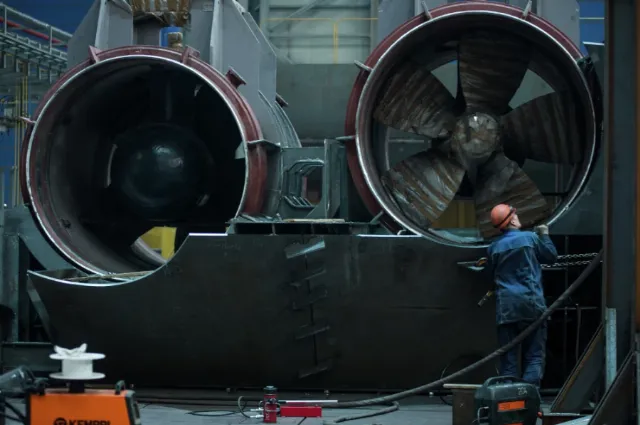Only half of Russian industrial companies have switched to domestic software. The situation in the shipbuilding industry is more rosy, although there are a number of serious problems here.
At the Neva 2025 exhibition and conference, which took place from September 23 to 26 in St. Petersburg, the transition of Russian shipbuilding enterprises to domestic software was also discussed. This is a time-consuming process, associated with numerous difficulties. However, Mashnews found out that the transition to Russian software in shipbuilding is proceeding slightly better than in other industries.
The work has been going on for a year now
SiSoft Group announced the beginning of the shipbuilding industry's transition to Russian software in September 2024. Then, at the Digital Industry of Industrial Russia (CIPR) forum in Nizhny Novgorod, the United Shipbuilding Corporation (USC) presented a digital model of the vessel, which was developed on the basis of the Model Studio CS software product from the Russian company SiSoft Development (part of the SiSoft Group of Companies). Mikhail Mishustin, Chairman of the Government of the Russian Federation, supported the USC leadership and thanked them for the timely selection of a CAD design developer.
Andrey Puchkov, General Director of USC, spoke at the CIPR plenary session about the results of the work of the Shipbuilding Industrial competence center, which develops "heavy" shipbuilding computer-aided design (CAD) systems. In 2024, it was necessary to find a company capable of creating a digital model or converting it from foreign software, said Puchkov. As a result, the developer was found, and his main achievement was the transformation of the digital model of the vessel from the British Aveva software into a Russian product. The model contains 5 million elements and allows you to maintain complex multi-level relationships.
In January 2025, USC announced that, together with SiSoft Development JSC, it had successfully completed the "Preliminary Design" stage of a particularly significant project "Refinement and implementation of domestic heavy-class shipbuilding CAD as a design environment and design and technological preparation of production."
USC has taken on a very serious large-scale task, Vadim Antonov, Director of Work with Key Customers at SiSoft Development JSC, noted during the session "Digitalization and CAD in Russian Shipbuilding" at the Neva 2025 exhibition.
A single data format
In October 2024, Mashnews reported that the Russian Maritime Register of Shipping was considering the possibility of switching domestic shipbuilding to a single digital format for ship design and information exchange throughout the ship's life cycle. The industry has already switched to 3D design, and it is important to organize the exchange of 3D models and metadata in a convenient, safe and universal format throughout the entire life cycle of the vessel and taking into account possible changes to it, including disposal. At the same time, it is important to take into account international experience, so the .ocx format is considered a priority.
The format .oxc is a configuration container of the Aveva Marine closed ecosystem, Vitaly Kotelnikov, Associate Professor at Ufa University of Science and Technology, PhD, explained to Mashnews during the Neva 2025 exhibition. It was the absolute leader in the global civil shipbuilding market, which historically explains its "international" status. The projects were created in different systems and formats, but .oxc is one of the most common.
The situation has changed radically with the industry's transition to Russian CAD systems. Modern strategy involves abandoning monolithic systems in favor of an ecosystem of better solutions. Interoperability based on open standards, rather than a single proprietary storage format, has become a key principle. This role of a single exchange language is performed by the international standard STEP (AP218/215) or the new Russian standard.
Thus, the industry is now solving the task of moving from isolated data to storing digital models, project documentation and its end-to-end management. Success depends on the development of uniform standards and reliable converters.
Half of the software is foreign anyway
The IT industry has doubled in five years, Alexander Korostylev, head of the TIM Department at SiSoft Development JSC (SiSoft Group), noted with reference to Mikhail Mishustin at the BIM in Practice conference on September 19 in St. Petersburg. The process of import substitution in the country has been launched, and the number of domestic solutions has increased three and a half times in IT, he added. According to Korostylev, we are talking about cumulative growth in services, products, and jobs.
The reasons for the reluctance of Russian companies to switch to domestic software are quite objective, Korostylev added. Once they bought foreign software, implemented it, and spent money. And now there are no funds for the purchase of Russian software. Companies often even have to make certain concessions to customers, Korostylev said.
"At the moment, approximately 70-80% of our implementations are concentrated in industrial sectors. Somewhere around 15% are civilian tasks, and about 10% are related to shipbuilding tasks that we have recently acquired," Korostylev summed up.
MASHNEWS HELP
• TIM — information modeling technologies.
• nanoCAD is a Russian platform for professional 2D/3D design, BIM modeling and automation of production of working documentation from Nanosoft Development LLC.
• Renga is a Russian BIM system for joint architectural design, development of load-bearing structures and internal engineering networks from Renga Software (a joint venture of Ascon and 1C companies).

